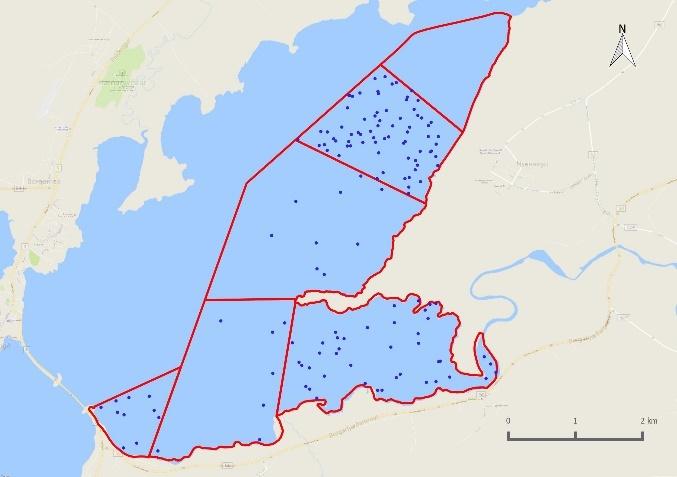
4 minute read
1. Introduction
The importance estuaries for waterbirds is well understood and documented (e.g. BirdLife International 2001; Boere et al. 2007; Prater 1981). Estuaries traditionally hold large numbers of waterbirds, especially during migratory staging periods and they are used by breeding and nonbreeding waterbirds during the breeding season. Some of the waterbirds staging in Iceland in spring and autumn are en route between Greenland or Arctic Canada and western Europe, migrations that involve two considerable sea-crossings, and the prior deposition of considerable fat reserves. Therefore, the stopover sites that Iceland provides are crucial to the success of these migratory journeys. As waterbirds are highly visible, reactive to change and easily counted, they can serve as useful indicators of the health of wetland ecosystems and, over time, reveal changes brought about by natural and anthropogenic processes.
Human infrastructure developments on, and close to, wetland habitats has led to modification and loss of wetlands and to increased disturbance to waterbirds (Boere et al. 2007, van de Kam et al. 2004). Similarly, pressure from recreational activities has increased in many areas that are important for waterbirds and this is among the main cases of population declines (Goss-Custard & Yates 1992; Davidson & Rothwell 1993; van de Kam et al. 2004).
Sea level rise and an increasing frequency of significant storms associated with climate change will result in an increased risk of coastal flooding in low-lying areas (IPCC 2007). This is likely to cause significant losses of feeding and roosting areas for waterbirds (Watkinson et al. 2004; Galbraith et al. 2005; Durell et al. 2006). Waterbirds will also be affected by the indirect effects of climate change, such as: land-use change; changes in the condition of wetlands; alterations in prey availability; changes in matching of the timing of (migratory bird) arrival dates and prey dynamics; altered predation effects; disease and parasitism, amongst others (Poulin & Mouritsen 2006; Boere et al. 2007; Mustin et al. 2007; Thompson et al. 2012; Sutherland et al. 2012).
With these changes in land use and climate change, many bird populations are experiencing dramatic contractions or expansions (McCarty 2001; Bohning-Gaese & Lemoine 2004; McDonald et al. 2012) and at this time of unprecedented change, information on population sizes and site usage is especially important.
Waterbirds use estuarine sites differently at different stages of the tide as the changing water levels are constantly changing the area available for foraging (Dias 2009; Granadeiro et al. 2006). Most species segregate themselves according to preferences for sediment penetrability and water depth. As the tide rises waterbirds are pushed towards their roosting areas as the water deepens and the mud and sand flats become inundated, and either roost adjacent to the foraging areas or fly to high tide roosts in other parts of the site, or beyond. And then, when the foraging areas begin to uncover as the tide recedes, these high tide aggregations break up and the birds disperse across the estuary again. While waterbird distribution is mainly governed by prey availability, high tide roosts can be a crucial factor. Loss of favoured roost sites can decrease survival rates due to the increased energetic costs of flying further to suitable roosting areas (Durell et al. 2005). Furthermore, the availability of suitable roost locations can influence the distribution of waders at low tide, as birds seek to reduce energetic expenditure by foraging close to roosting areas (Rogers 2003), even if there are more profitable foraging areas in the vicinity (Dias et al. 2006; van Gils et al. 2006). The selection of these
foraging and roosting places can change between and within seasons depending on factors such as weather (wind direction), prey availability and variations in human disturbance.
So, in order to be fully informed about how waterbirds make use of sites, it is necessary to collate information on their abundance and distribution throughout the tidal cycle, or at least during low tide and high tide periods. And, information on the seasonality of site use is required for the complete picture. Waterbird usage of estuarine sites also changes through the year, with sites being used as stopover sites during spring and or autumn migration, during the breeding season, as post-breeding moulting sites or as wintering sites.
The aim of this study is to investigate the abundance, distribution and seasonality of waterbirds in the estuarine parts of the Andakíll Ramsar site in Borgarfjörður, western Iceland. The result is a baseline dataset with information on how waterbirds use the protected area during the spring and autumn staging periods and during the breeding season. It is hoped that when future studies are made on the waterbirds on the site, they can be conducted in a way that allows comparisons with the data collected as part of this study. In order to facilitate further monitoring, comprehensive rationale and methodology for this survey is presented as a Survey Handbook (Stroud & Tierney 2017).










